2020最新小升初英语必考语法知识点归纳
2020小升初英语语法大全
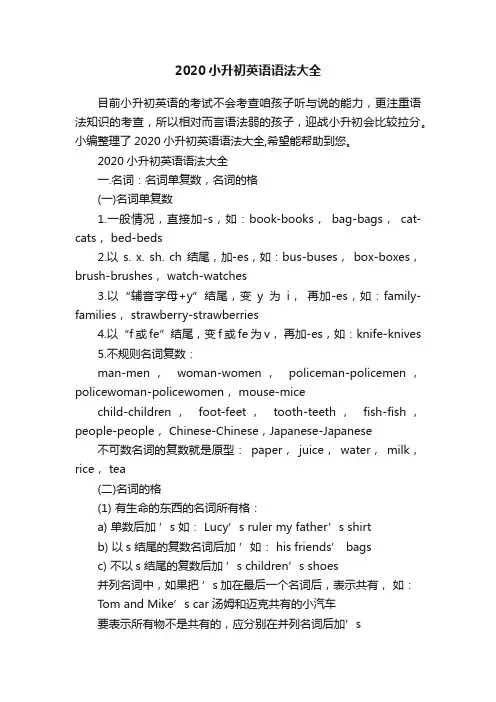
2020小升初英语语法大全目前小升初英语的考试不会考查咱孩子听与说的能力,更注重语法知识的考查,所以相对而言语法弱的孩子,迎战小升初会比较拉分。
小编整理了2020小升初英语语法大全,希望能帮助到您。
2020小升初英语语法大全一.名词:名词单复数,名词的格(一)名词单复数1.一般情况,直接加-s,如:book-books,bag-bags,cat-cats, bed-beds2.以s. x. sh. ch结尾,加-es,如:bus-buses,box-boxes,brush-brushes, watch-watches3.以“辅音字母+y”结尾,变y为i,再加-es,如:family-families, strawberry-strawberries4.以“f或fe”结尾,变f或fe为v,再加-es,如:knife-knives5.不规则名词复数:man-men,woman-women,policeman-policemen,policewoman-policewomen, mouse-micechild-children,foot-feet,tooth-teeth,fish-fish,people-people, Chinese-Chinese,Japanese-Japanese 不可数名词的复数就是原型:paper,juice,water,milk,rice, tea(二)名词的格(1) 有生命的东西的名词所有格:a) 单数后加’s 如:Lucy’s ruler my father’s shirtb) 以s 结尾的复数名词后加’如:his friends’ bagsc) 不以s 结尾的复数后加’s children’s shoes并列名词中,如果把’s加在最后一个名词后,表示共有,如:Tom and Mike’s car 汤姆和迈克共有的小汽车要表示所有物不是共有的,应分别在并列名词后加’sTom’s and Mike’s cars 汤姆和麦克各自的小汽车(2)表示无生命东西的名词通常用“ of +名词”来表示所有关系:如:a picture of the classroom a map of China二.冠词:不定冠词,定冠词种类:(1)不定冠词:a / an a unit / an uncle元音开头的可数名词前用an :an egg / an apple / an orange / an eraser / an answer / an ID card / an alarm clock / an actor / an actress /an e-mail / an address / an event / an example / an opera / an houran old man / an interesting book / anexciting sport / an action movie / an art lesson /(2)定冠词:the the egg the plane2. 用法:定冠词的用法:(1)特指某(些)人或某(些)物: The ruler is on the desk.(2)复述上文提到的人或物:He has a sweater. The sweater is new.(3)谈话双方都知道的人或物:The boys ar en’t at school.(4)在序数词前:John’s birthday is February the second.(5)用于固定词组中: in the morning / afternoon / evening不用冠词的情况:(1)专有名词前:China is a big country.(2)名词前有定语:this , that , my , your , some, any ,no 等:This is my baseball.(3)复数名词表示一类人和事:Monkeys c an’t swim. They are teachers.(4)在节日,日期,月份,季节前:T oday is Christmas Day. It’s Sunday.(5)一日三餐前:We have breakfast at 6:30.(6)球类棋类运动前:They often play football after class. He plays chess at home.* 但乐器前要用定冠词:I play the guitar very well.(7)学科名称前:My favorite subject is music.(8)在称呼或头衔的名词前:This is Mr Li.(9)固定词组中:at noon at night by bus三、代词:人称代词,物主代词人称代词物主代词主格宾格第一人称单数 I(我) me my(我的)复数 we(我们) us our(我们的)第二人称单数 you(你) you your(你的)复数 you(你们) you your(你们的)第三人称单数 he(他) him his(他的)she(她) her her(她的)it(它) it its(它的)复数 they(他们/她们/它们) them their(他们的/她们的/它们的)四、形容词,副词:比较级,最高级(一)、形容词的比较级1、形容词比较级在句子中的运用:两个事物或人的比较用比较级,比较级后面一般带有单词than。
小升初英语语法知识点大全
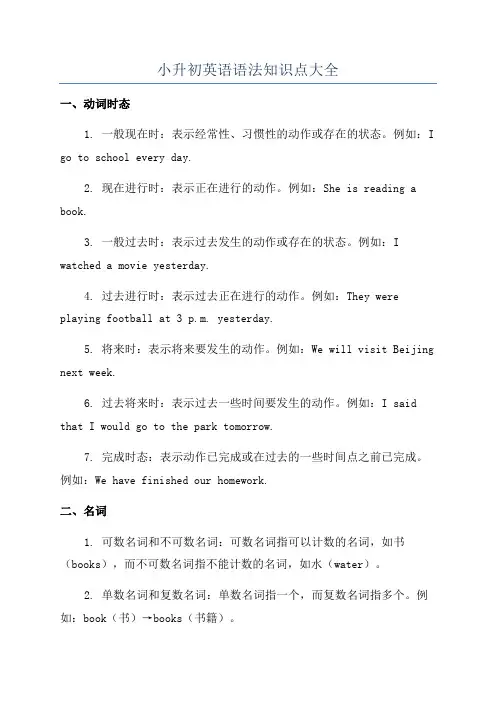
小升初英语语法知识点大全一、动词时态1. 一般现在时:表示经常性、习惯性的动作或存在的状态。
例如:I go to school every day.2. 现在进行时:表示正在进行的动作。
例如:She is reading a book.3. 一般过去时:表示过去发生的动作或存在的状态。
例如:I watched a movie yesterday.4. 过去进行时:表示过去正在进行的动作。
例如:They were playing football at 3 p.m. yesterday.5. 将来时:表示将来要发生的动作。
例如:We will visit Beijing next week.6. 过去将来时:表示过去一些时间要发生的动作。
例如:I said that I would go to the park tomorrow.7. 完成时态:表示动作已完成或在过去的一些时间点之前已完成。
例如:We have finished our homework.二、名词1. 可数名词和不可数名词:可数名词指可以计数的名词,如书(books),而不可数名词指不能计数的名词,如水(water)。
2. 单数名词和复数名词:单数名词指一个,而复数名词指多个。
例如:book(书)→books(书籍)。
3. 可数名词的复数形式:许多词在复数时需进行变位,如cat(猫)→cats(猫)、baby(婴儿)→babies(婴儿)。
4. 不可数名词的用法与数量表示:不可数名词无复数形式,不能与数词或a/an连用。
对于不可数名词表示的量,需使用量词或具体表示数量的词语,如a bottle of water、a cup of tea。
三、形容词和副词1. 形容词用法:形容词修饰名词,用来描述名词的性质或特征。
例如:a big dog(一只大狗)。
2. 形容词的比较级和最高级:形容词的比较级用于表示两个人或物之间的比较,如taller(更高),而最高级则用于表示三个或三个以上人或物之间的比较,如the tallest(最高的)。
最全小升初英语语法点
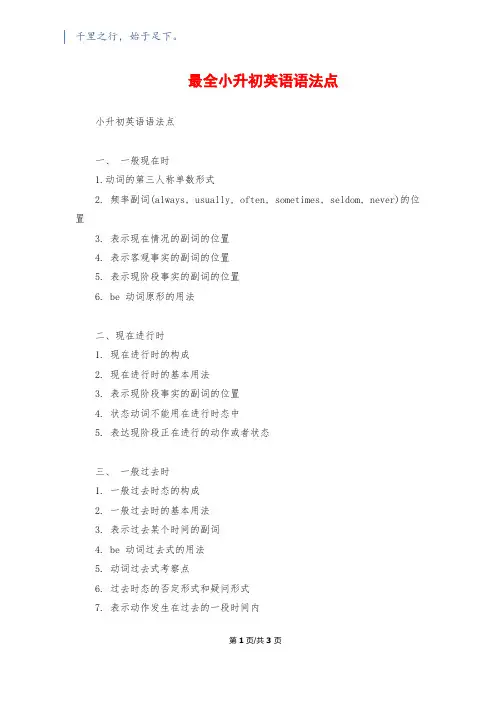
千里之行,始于足下。
最全小升初英语语法点小升初英语语法点一、一般现在时1.动词的第三人称单数形式2. 频率副词(always, usually, often, sometimes, seldom, never)的位置3. 表示现在情况的副词的位置4. 表示客观事实的副词的位置5. 表示现阶段事实的副词的位置6. be 动词原形的用法二、现在进行时1. 现在进行时的构成2. 现在进行时的基本用法3. 表示现阶段事实的副词的位置4. 状态动词不能用在进行时态中5. 表达现阶段正在进行的动作或者状态三、一般过去时1. 一般过去时态的构成2. 一般过去时的基本用法3. 表示过去某个时间的副词4. be 动词过去式的用法5. 动词过去式考察点6. 过去时态的否定形式和疑问形式7. 表示动作发生在过去的一段时间内第1页/共3页锲而不舍,金石可镂。
8. 常用的表示过去的时间四、现在完成时1. 现在完成时的构成2. 现在完成时的基本用法3. 表示延续到现在的时间段4. 表示完成的动作对现在的影响5. 表示动作发生在过去一段时间内或者有可能发生的时间6. yet 与 already 的用法7. just 的用法8. 特殊疑问句和一般疑问句的用法五、一般将来时1. 一般将来时的构成2. 一般将来时的基本用法3. 表示将来时间的状语4. 表示计划或意图5. 表示习惯或按照惯例6. be going to 的用法7. will 与 shall 的用法8. 表示即将发生或者肯定会发生六、时态混用1. 现在时与现在进行时的区别2. 过去时与现在完成时的区别3. 一般过去时与一般将来时的区别4. 现在进行时与将来进行时的区别七、动词时态1. 动词时态的定义和分类千里之行,始于足下。
2. 时态与语态的区别3. 时态的确定以上是小升初英语语法点的一些例子,希望对你有所帮助。
第3页/共3页。
2020小升初英语必考知识点总结
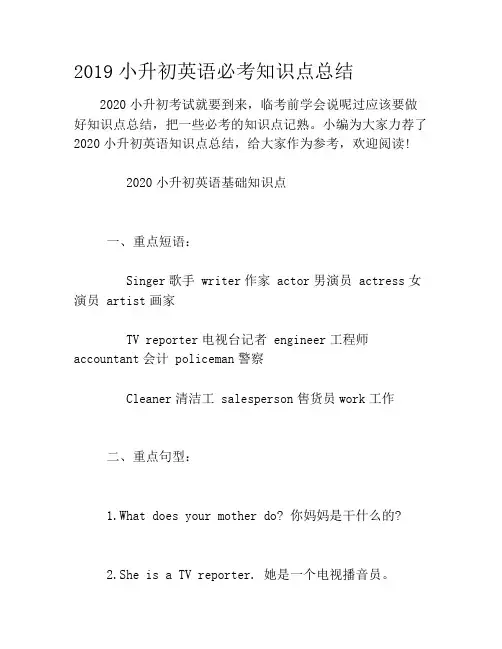
2019小升初英语必考知识点总结2020小升初考试就要到来,临考前学会说呢过应该要做好知识点总结,把一些必考的知识点记熟。
小编为大家力荐了2020小升初英语知识点总结,给大家作为参考,欢迎阅读!2020小升初英语基础知识点一、重点短语:Singer歌手 writer作家 actor男演员 actress女演员 artist画家TV reporter电视台记者 engineer工程师accountant会计 policeman警察Cleaner清洁工 salesperson售货员work工作二、重点句型:1.What does your mother do? 你妈妈是干什么的?2.She is a TV reporter. 她是一个电视播音员。
3.Where does she work? 她在哪儿工作?4.She works in a school. 她在学校工作。
5.How does she go to work? 她怎么去工作?6.She goes to work by bus. 她乘公交车去工作。
三、重点语法:1、一些由动词变化而来的职业名词:teach-teacher clean-cleaner sing-singer dance-dancerdrive-driver write-writer TV report-TV reporteract-actor act-actress art-artist engine-engineerplay basketball/football/baseball-basketball/football/baseball player2、提问职业有两种方式: What is your father? 或者What does your father do?3、a/an的区别,跟元音发音有关。
例如:a singer/writer/TV reorteranactor/actress/artist/engineer/accountant4、What are you going to be ?问的是长大想干什么,注意用"be". I'm going to be a …记住p61和63有关职业信息的内容5、记住几个地点: shoe /car/air-conditioner company? 鞋/汽车/空调公司6、做"对句子划线部分提问"试题时,一般应该遵循三个步骤:(1)确定与句子划线部分相应的特殊疑问词,并且特殊疑问词代替相应的划线部分。
小升初英语语法重点复习总结
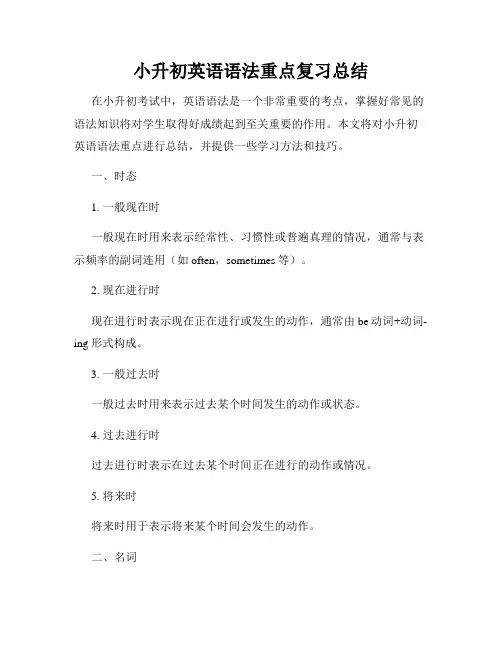
小升初英语语法重点复习总结在小升初考试中,英语语法是一个非常重要的考点,掌握好常见的语法知识将对学生取得好成绩起到至关重要的作用。
本文将对小升初英语语法重点进行总结,并提供一些学习方法和技巧。
一、时态1. 一般现在时一般现在时用来表示经常性、习惯性或普遍真理的情况,通常与表示频率的副词连用(如often,sometimes等)。
2. 现在进行时现在进行时表示现在正在进行或发生的动作,通常由be动词+动词-ing形式构成。
3. 一般过去时一般过去时用来表示过去某个时间发生的动作或状态。
4. 过去进行时过去进行时表示在过去某个时间正在进行的动作或情况。
5. 将来时将来时用于表示将来某个时间会发生的动作。
二、名词1. 可数名词和不可数名词可数名词是指可以用数目来计量的名词,可以有单数和复数形式;不可数名词是指不能计量或者无复数形式的名词。
2. 名词所有格名词所有格用于表示某物属于某人,通常在名词后加上's。
三、代词1. 人称代词人称代词用于代指人或事物。
2. 物主代词物主代词用于表示所有关系。
3. 反身代词反身代词用于表示某人或某物为动作的主语与受事者相同。
四、动词1. 动词的时态和语态动词分为一般现在时、一般过去时、现在进行时、一般将来时等时态。
2. 动词的不定式不定式通常由动词原形前加to构成,用来表示目的、原因或结果。
3. 动词的ing形式动词的ing形式可以作为动词的主语、宾语、表语和定语。
五、形容词和副词1. 形容词的比较级和最高级形容词的比较级用于表示两个人或物之间的比较;最高级用于表示三个或三个以上人或事物之间的比较。
2. 副词的比较级副词的比较级用于表示动作的程度高低。
六、介词和短语介词用于连接其他词语,并表示词语之间的关系。
七、连词和从句连词用于连接句子、短语或词语。
以上是关于小升初英语语法的重点复习总结。
希望同学们能够通过学习这些语法知识,提高自己的英语水平,并在考试中取得好成绩。
2020小升初英语必考知识点大全
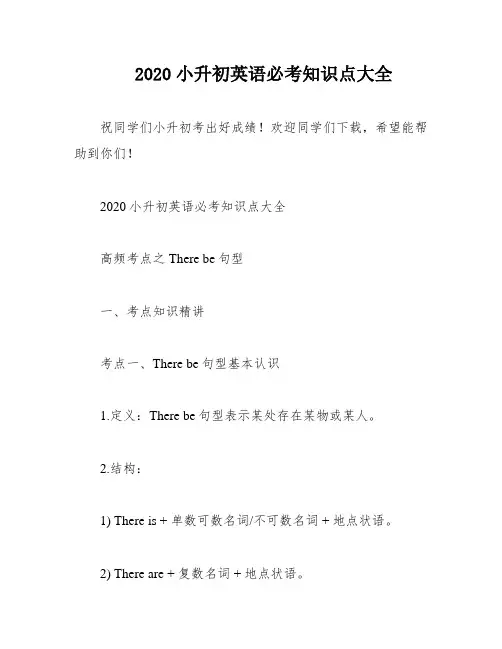
2020小升初英语必考知识点大全祝同学们小升初考出好成绩!欢迎同学们下载,希望能帮助到你们!2020小升初英语必考知识点大全高频考点之There be句型一、考点知识精讲考点一、There be句型基本认识1.定义:There be句型表示某处存在某物或某人。
2.结构:1) There is + 单数可数名词/不可数名词 + 地点状语。
2) There are + 复数名词 + 地点状语。
其中,There是引导词,在句子中不充当任何成分,翻译时不必翻译出来。
句子的主语是某人或某物,是be动词后面的名词。
例如:There is some water in the cup。
→ 杯子里有一些水。
There are many students in the classroom。
→ 教室里有许多学生。
考点二、各种句型转化1.变成否定句陈述句中的肯定句变否定句有两种形式:一种是含有be动词和系动词或情态动词的句子,变否定句时直接在be动词或情态动词后面加not,其他不变,照抄原句。
另外一种是谓语动词是实意动词的句子,需要在实意动词前面加助动词do/does,然后加not,之后把实意动词变成原形,然后句子其他不变照抄。
There be句型的否定式的构成和含有be动词的其他句型一样,在be后加上not或no即可。
注意not和no的不同:not是副词,no为形容词,not a/an/any + n.相当于no + n。
例如:There XXX(变否定句)There is not a woman in our classroom。
或者 There is no woman in our classroom.2.变成一般疑问句陈述句变一般疑问句有两种方式:一种是含be动词或情态动词的句子,直接把be动词或情态动词提前,同时第一个单词的第一个字母变大写,其他顺序不变照抄,后面句号变问号。
另一种是不含be动词或情态动词的句子,变一般疑问句时,在句首加助动词do或does,其他顺序不变照抄,同时注意后面的谓语动词变成原形,句首的首字母大写,句号变成问号。
小升初小学英语语法复习要点归纳
动词+s的变化规则
1.一般情况下,直接加-s,如:cook-cooks, milk-milks
2.现在进行时的肯定句基本结构为be+动词ing.
3.现在进行时的否定句在be后加not。
4.现在进行时的一般疑问句把be动词调到句首。
动词加ing的变化规则
1.一般情况下,直接加ing,如:cook-cooking
2.以不发音的e结尾,去e加ing,如:make-making, taste-tasting
5.不规则动词过去式:am,is-was, are-were, do-did, see-saw, say-said, give-gave, get-got, go-went, come-came, have-had, eat-ate, take-took, read-read, write-wrote, draw-drew, drink-drank, fly-flew, ride-rode, speak-spoke, sweep-swept, swim-swam, sit-sat
动词过去式变化规则:
1.一般在动词末尾加-ed,如:pull-pulled, cook-cooked
2.结尾是e加d,如:taste-tasted
3.末尾只有一个元音字母和一个辅音字母的重读闭音节,应双写末尾的辅音字母,再加-ed,如:stop-stopped
2020最新小升初英语必考知识点大全
2020最新小升初英语必考知识点大全2020 XXXHigh-frequency Exam Point - There be Sentence StructureI。
n to the Exam PointExam Point 1: XXX1.n: The There be XXX.2.Structure:1) XXX.2) There are + XXX.There is the introductory word and does not n as any part of the XXX。
there is no need to translate it。
The subject of the sentence is someone or something。
which is the noun after the be verb.For example: There is some water in the cup.There are many students in the classroom.Exam Point 2: us XXX1.Changing to XXXThere are two ways to change XXX:One is to add "not" directly after the be verb or modal verb in the affirmative sentence。
while keeping the rest of the sentence the same.The other is to add the auxiliary verb "do/does" before the main verb and "not" after it。
then change the main verb to its base form。
【结尾】2020年PEP小升初英语语法大全
【关键字】结尾名词一、可数名词与不可数名词的区别普通名词所表示的人或事物是可以按个数计算的,这类名词叫可数名词。
可数名词分为个体名词(表示某类人或事物中的个体,如worker, farmer, desk, factory等)和集体名词(表示作为一个整体来看的一群人或一些事物,如people,family 等)。
如果普通名词所表示的事物是不能按个数来计算的,这类名词就叫不可数名词。
不可数名词分为物质名词(表示无法分为个体的物质,如meat, rice, water, milk, orange 等)和抽象名词(表示动作、状态、情况、品质等抽象概念,如work, homework, time, health, friendship等)。
二、可数名词可数名词有单数和单数两种形式。
指一个人或一件事物时,用单数形式;指两个或多个人或事物时用单数形式。
名词由单数形式变成单数形式的规则如下:1. 一般的名词词尾直接加-s 。
如:book → books room → rooms house → houses day → days2. 以s,ss, ch,sh, x 结尾的名词,在词尾加-es 。
如:bus → buses glass → glasses watch → watches dish → dishes box → boxes3. 以"辅音字母+y"结尾的名词,要先将y改为i再加-es。
如:city → cities body → bodies factory → factories等等。
4. 以f 或fe 结尾的名词,要将f或fe改为v再加-es。
如:half → halves leaf → leaves knife → knives wife → wives5. 特例[悄悄话:特例常常考,要记住。
]① child → children② man → men woman → women policeman → policemen police woman-policewomen③ tomato → tomatoes potato → potatoes [悄悄话:初中英语以o 结尾的名词变单数时只有这两个词加-es,其余的当然加-s喽!如:photo → photos ]④ foot → feet tooth → teeth [悄悄话:oo变成ee。
2024小升初英语必考语法知识点归纳
2024小升初英语必考语法知识点归纳2024字小升初英语考试是学生们升入初中的重要关卡之一,英语语法是考试重点和难点。
以下是2024小升初英语必考的语法知识点归纳,供同学们参考复习。
一、动词时态1.一般现在时:表示经常性的动作或客观事实。
例如:I go to school every day.2.现在进行时:表示现阶段正在进行的动作。
例如:She is studying English now.3.一般过去时:表示已经完成的过去的动作。
例如:I watched a movie last night.4.过去进行时:表示过去一些时间段正在进行的动作。
例如:They were playing chess this morning.5.将来时:表示将来要发生的动作或存在的状态。
例如:I will go on a trip next week.6.过去将来时:表示过去一些时间节点上将要发生的动作。
二、名词1.可数名词与不可数名词:可数名词有单数和复数之分,不可数名词只有单数形式。
例如:table(可数), water(不可数)2.名词所有格:表示所有关系时,在名词后加's。
例如:Tom's book(汤姆的书)3.复合名词:由两个或两个以上名词构成并有一定结构的名词。
例如:classroom, basketball三、形容词与副词1.形容词用来修饰名词,副词用来修饰动词、形容词或其他副词。
例如:She is a beautiful girl.(形容词修饰名词)He runs fast.(副词修饰动词)2. 形容词的比较级和最高级:一般在形容词后面加-er表示比较级,在形容词前面加the最高级。
例如:He is taller than me.(比较级)He is the tallest boy in our class.(最高级)四、代词1. 人称代词:主格形式有I, you, he, she, it, we, they;宾格形式有me, you, him, her, it, us, them。
- 1、下载文档前请自行甄别文档内容的完整性,平台不提供额外的编辑、内容补充、找答案等附加服务。
- 2、"仅部分预览"的文档,不可在线预览部分如存在完整性等问题,可反馈申请退款(可完整预览的文档不适用该条件!)。
- 3、如文档侵犯您的权益,请联系客服反馈,我们会尽快为您处理(人工客服工作时间:9:00-18:30)。
精选教育类文档,如果您需要本文档,请点击下载@_@
2020最新小升初英语必考语法知识点归纳
第1讲字母
1、英语中共有26个字母。
Aa,Ee,Ii,Oo,Uu是元音字母,Yy是半元音字母,其余是辅音字母。
英语单词就是由这26个字母组合而成的。
Aa和Ii可以独立成词,分别表示“一个(张……)”和“我”的意思,Ii翻译成“我”时要大写。
2、英语字母可以分为印刷体和书写体。
在书、报、杂志上见到
的一般都是印刷体。
在四线三格上书写时应注意书写位置,可
以记住以下口诀:大写字母不顶格,小写字母占满格。
书写时
还要注意字母的笔顺。
3、英语句子的第一个单词的首字母要大写。
单词与单词之间在
书写时必须保持适当的距离,一般以空出一个小写字母的宽
度为宜。
句子的末尾要有标点符号。
4、英语中的句号是一个实心圆点(.),省略号是三个居下的实
心圆点(…),英语中没有顿号和书名号,顿号用逗号替代,
书名用斜体字表示。
5、英语缩写词
PRC中华人民共和国UN 联合国WHO 世界卫生组织NBA 美国职业篮球联赛KFC 肯德基IT 信息技术EQ 情
商CCTV 中国中央电视台kg 千克 a.m. 上午USA 美国HK 香港WTO 世界贸易组织CBA 中国男子篮球联
赛ATM 自动柜员机ID 身份证CPU 中央处理
器BBC 英国广播公司cm 厘米p.m. 下午
6、26个英语字母按照相同的元音因素进行归类:
/ eɪ/ Aa Hh Jj Kk
/ i: / Ee Bb Cc Dd Gg Pp Tt Vv (Zz) / a
ɪ/ Ii Yy /ǝʊ/ Oo
/ju:/ Uu Qq Ww
/ e / Ff Ll Mm Nn Ss Xx Zz /ɑ: /
Rr
第2讲语音
1、音素:语音的最小单位。
英语中共有48个音素,其中元音音素20个,辅音音素28个。
元音
单元音/i:/,/ɪ/,/ɜ:/,/ə/,/ɑ:/,//,/ɔ:/,/ɒ
/,/u:/,/ʊ/,/e/,/æ/
双元音/eɪ/,/aɪ/,/ɔɪ/,/əʊ/,/aʊ/,/ɪǝ/,/eə/,/ʊə/
辅音
清辅音/p/,/t/,/k/,/t/,/tr/,/ts/,/f/,/θ/,/s/,/∫/,/h/
浊辅音/b/,/d/,/g/,/dʒ/,/dr/,/dz/,/V/,/ð/,/z/,/ʒ/,/r/,/m/,/n/,/ŋ/,/l/,/w/,/j/
2、元音:发音时气流不受阻碍。
元音分为单元音和双元音两类。
单元音发音时唇形和舌位不变;双元音发音时由一个元音向另一个元音滑动,唇形和舌位有一个变化过程,且前重后轻,前长后短。
3、辅音:发音时气流受到阻碍。
辅音分为清辅音和浊辅音两类。
清辅音发音时声带不振动;浊辅音发音时声带振动。
4、音标:用来记录音素的符号。
为了避免与字母混淆,音标被放在斜括号/ /内。
5、英语中的一个字母或字母组合在不同的单词中发音可能是不一样的,而相同的发音对应的字母或字母组合也可能不完全相同。
6、开音节:以元音字母结尾或以一个元音字母加一个辅音字母再加不发音的e结尾
(r除外)的音节。
元音字母在开音节中读长音,即该字母的名称音。
闭音节:以一个或几个辅音字母(r除外)结尾。
元音字母在闭音节中读短音。
a e i o u 开音节/e
ɪ/ name /i:/ we she /aɪ/ hi white
/əʊ/ go note /ju:/ or /u:/ use 闭音节
/æ/ map
/e/ desk
/ɪ/ sit
/ɒ/ clock
// cup
第3讲名词
名词是指表示人和事物名称的词,可以分为专有名词和普通名
词两大类。
1、专有名词:特定的人、地方、机构等专有的名称。
第一个字
母通常要大
写。
e.g. Jim Green,New York,Bank of China,Peking University 星期、月份、节日、学科、报刊名也是
专有名词。
e.g. Monday,May,Christmas,Spring Festival,Maths,China Daily
2、普通名词:表示一类人或物或抽象概念的名称。
普通名词又
可以分为四类: 个体名词——表示某类人或东西中的个体,如:student , desk 集体名词——表示若干个体组成
的集合体,如:class , family
物质名词——表示无法分为个体的物质名称,如:
water , rice , sand,hair 抽象名词——表示情感,
状态,品质等抽象名称,如:love ,carelessness 个体名
词和集体名词多数可以用数目来计算,称为可数名词,有单、
复数形式;物质名词和抽象名词通常无法用数目计算,称为
不可数名词,一般只有一种形式。
注意:
①集体名词被看作一个整体时,表达单数概念。
e.g. His family was well known in the town.
他家在镇里是名门望族。
②集体名词被看作若干个体的集
合时,表达复数概
念。
e.g. His family are waiting for him. 她的
家人正在等他。
③集体名词表达多个集体时,也有复数形式。
e.g. Our village is made up of 300 families.
我们村有300户人家。
3、可数名词复数形式的构成规则:
①一般名词在末尾直接加s,清辅音后读/ s /,浊辅音和元音后读/ z / e.g. book-books,bag-bags,cat-cats,bed-beds ②以s、x、sh、ch结尾,加es,读
/ IZ /
e.g. bus-buses,box-boxes,brush-brushes,watch-watches ③以辅音字母+y结尾,变y为i,再加es,读/ z / e.g. baby-babies,library-libraries,factory-factories ④以f或fe结尾,变f或fe为v,再加es,读/ vz / e.g. thief-thieves,knife-knives
⑤以o结尾,表示无生命的物体时加s, 表示有生命的物体时,加es,都读/ z / e.g. photo-photos,piano-pianos,radio-radios,zoo-zoos
potato-potatoes,tomato-tomatoes,mango-mangoes,hero-heroes
⑥不规则变化 e.g. man-men
child-children foot-feet fish-fish
woman-women mouse-mice tooth-teeth sheep-sheep
policeman-policemen ox-oxen
goose-geese deer-deer
▲fish表示鱼的数量时,单复数同形;表示鱼的种类时,复数为
fishes. e.g. My cat had two fish for lunch.
You can see a lot of different fishes in the lake.
4、不可数名词一般只有原形,没有复数形式,但是可以借助量词表示一定的数量。
如果表达两个或两个以上的概念时,量词需要用复数形式,不可数名词不。
